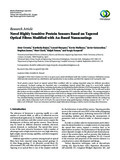Mostrar el registro sencillo del ítem
Novel highly sensitive protein sensors based on tapered optical fibres modified with Au-based nanocoatings
| dc.creator | Urrutia Azcona, Aitor | es_ES |
| dc.creator | Bojan, Kartheka | es_ES |
| dc.creator | Marques, Leonel | es_ES |
| dc.creator | Mullaney, Kevin | es_ES |
| dc.creator | Goicoechea Fernández, Javier | es_ES |
| dc.creator | James, Stephen | es_ES |
| dc.creator | Clark, Matt | es_ES |
| dc.creator | Tatam, Ralph | es_ES |
| dc.creator | Korposh, Sergiy | es_ES |
| dc.date.accessioned | 2018-03-21T18:15:16Z | |
| dc.date.available | 2018-03-21T18:15:16Z | |
| dc.date.issued | 2016 | |
| dc.identifier.issn | 1687-725X (Print) | |
| dc.identifier.issn | 1687-7268 (Electronic) | |
| dc.identifier.uri | https://hdl.handle.net/2454/28047 | |
| dc.description.abstract | Novel protein sensors based on tapered optical fibres modified with Au coatings deposited using two different procedures are proposed. Au-based coatings are deposited onto a nonadiabatic tapered optical fibre using (i) a novel facile method composed of layer-by-layer deposition consisting of polycation (poly(allylamine hydrochloride), PAH) and negatively charged SiO2 nanoparticles (NPs) followed by the deposition of the charged Au NPs and (ii) the sputtering technique. The Au NPs and Au thin film surfaces are then modified with biotin in order to bind streptavidin (SV) molecules and detect them. The sensing principle is based on the sensitivity of the transmission spectrum of the device to changes in the refractive index of the coatings induced by the SV binding to the biotin. Both sensors showed high sensitivity to SV, with the lowest measured concentration levels below 2.5 nM. The calculated binding constant for the biotin-SV pair was 2.2 × 10−11 M−1 when a tapered fibre modified with the LbL method was used, with a limit of detection (LoD) of 271 pM. The sensor formed using sputtering had a binding constant of 1.01 × 10−10 M−1 with a LoD of 806 pM. These new structures and their simple fabrication technique could be used to develop other biosensors. | en |
| dc.description.sponsorship | This work was supported in part by the Spanish Ministry of Economy and Competitiveness-CICYT-FEDER TEC2013-43679R Research Grant and UPNA predoctoral and mobility research grants. The authors also acknowledge the support of UK Engineering and Physical Sciences Research Council Platform grant (EP/H02252X/1) and responsive mode grant (EP/L010437/1). The authors would like also to acknowledge the support of the EPSRC EP/G061661/1 Advanced Ultrasonics Platform Grant, University of Nottingham, Dean of Engineering Faculty Award. | en |
| dc.format.mimetype | application/pdf | en |
| dc.language.iso | eng | en |
| dc.publisher | Hindawi Publishing Corporation | en |
| dc.relation.ispartof | Journal of Sensors, Volume 2016, Article ID 8129387, 11 pages | en |
| dc.rights | Copyright © 2016 Aitor Urrutia et al. This is an open access article distributed under the Creative Commons Attribution License, which permits unrestricted use, distribution, and reproduction in any medium, provided the original work is properly cited. | en |
| dc.rights.uri | https://creativecommons.org/licenses/by/4.0/ | |
| dc.subject | Novel protein sensors | en |
| dc.subject | Tapered optical fibers | en |
| dc.subject | Au-based coatings | en |
| dc.title | Novel highly sensitive protein sensors based on tapered optical fibres modified with Au-based nanocoatings | en |
| dc.type | Artículo / Artikulua | es |
| dc.type | info:eu-repo/semantics/article | en |
| dc.contributor.department | Ingeniería Eléctrica y Electrónica | es_ES |
| dc.contributor.department | Ingeniaritza Elektrikoa eta Elektronikoa | eu |
| dc.rights.accessRights | Acceso abierto / Sarbide irekia | es |
| dc.rights.accessRights | info:eu-repo/semantics/openAccess | en |
| dc.identifier.doi | 10.1155/2016/8129387 | |
| dc.relation.projectID | info:eu-repo/grantAgreement/MINECO//TEC2013-43679-R/ES/ | en |
| dc.relation.publisherversion | https://dx.doi.org/10.1155/2016/8129387 | |
| dc.type.version | Versión publicada / Argitaratu den bertsioa | es |
| dc.type.version | info:eu-repo/semantics/publishedVersion | en |
| dc.contributor.funder | Universidad Pública de Navarra / Nafarroako Unibertsitate Publikoa | es |



